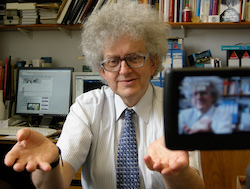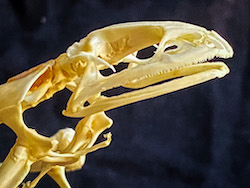Science Communication as a Moral Imperative
Dr. Foley has written a very good essay appealing to his fellow scientists to regard research communication as a moral imperative. While I agree with his argument in spirit, I strongly contend the message in principal. It is the public that has the moral imperative to listen to scientists.
 I am a filmmaker whose job it is to communicate science to the public, primarily on environmental and conservation issues. In the course of my work, I have interviewed scores of scientists and have yet to find one who wasn’t fully engaged in sharing his research. A lot of them begin interviews with a nervous admission that they lack the talent of public speaking, as if it was a moral failing on their part. It isn’t. Scientists, like people in general, are a mixed-bag of strengths and weaknesses. Certainly, they can work at their communication skills but not at the expense of their research. It’s my job to listen and understand their work and put it into a form that is accessible to the public.
I am a filmmaker whose job it is to communicate science to the public, primarily on environmental and conservation issues. In the course of my work, I have interviewed scores of scientists and have yet to find one who wasn’t fully engaged in sharing his research. A lot of them begin interviews with a nervous admission that they lack the talent of public speaking, as if it was a moral failing on their part. It isn’t. Scientists, like people in general, are a mixed-bag of strengths and weaknesses. Certainly, they can work at their communication skills but not at the expense of their research. It’s my job to listen and understand their work and put it into a form that is accessible to the public.
The same is true for writers and artists, members of the public that may lack a rigorous science background but have the skills to interpret and effectively present science to non-scientists. Instead of imploring scientists to divide their intellectual attention between science and communication, people with communications skills; artists, writers and musicians need to engage scientists and present their research to the public through art and the humanities.

Some scientists have an innate knack at conveying the wonder and excitement of science. My favorite is Jacob Bronowski, mathematician/poet who wrote and hosted the Ascent of Man television series in the early 1970s. I was just a kid then, my head addled with Gilligan’s Island and Beverly Hillbillies, but his calm command of ideas coupled with stellar visuals captured my imagination for a lifetime. The high point for me was Episode 1 Lower Than the Angels 11:00 – 16:00. Dr. Bronowski walks over the rocks of the Olduvai Gorge, wearing a tie, his wool coat thrown over his shoulder and sits down on a boulder to expound on the teeth of a fossil ape. Quietly, almost in a whisper, he relates how his abstract mathematical skills helped to imagine the life of a proto-human ancestor millions of years ago. “… and it transmitted to me a sense of excitement which I remember this instant. I, at over 40, after having spent a lifetime on doing abstract math on the shape of things, suddenly saw my knowledge reach back 2 million years to shine a searchlight into the history of man.” It was brilliant television and a highly successful series.

The television of my youth no longer exists. It’s been replaced by an tsunami of media. YouTube currently uploads 30,000 hours of video content/hour. Filmmakers and scientists have taken advantage of this phenomenon in ways unimaginable 30 years ago. Brady Haran and Martyn Poliakoff, University of Nottingham, have produced the Periodic Videos channel that looks at the universe one element at a time. It was birthed in 2008 with a small grant from Engineering and Physical Sciences Research Council and since that time has earned over 159 million views. Professor Pollakov, awed by its reach, said “With a few hours of work, I have lectured to more students than I have reached in my entire career.” Their success with chemistry led to a mathematics spinoff called Numberphile. I spend way too much time on both channels.
Communication = Message + Distribution
One of the frustrations of my job is that once the film is completed, people think they can park it on YouTube and walk away. It doesn’t work like that. The real work begins after the film is done. The social sciences can offer evidence evidence-based clues on how to effectively communicate important issues to hard-to-reach audiences.

The Ravenswood Media YouTube channel has close to 60 clips. The majority are science oriented. Only two clips; Blind White Crayfish and Frog Skeleton have proved to be evergreen without any effort. Probably because the subject matter tickles the public’s interest in a way that one cannot predict. I suspect that it’s because both clips are fairly short and contain content that is of use to teachers. Plus, the interviewees exhibit a particular joy with their topics that appeals to viewers.
I believe on the whole that scientists are doing an incredible job by making themselves available to the public. Is there room for improvement? Absolutely. But I’d like to turn the tables and say that artists, musicians, writers, and filmmakers need to engage scientists. I would like to see more science as a requirement for film schools, journalism and liberal arts degrees. The thirst for science is embedded naturally in humans. We just need to cultivate and nurture it through our respective skills.

